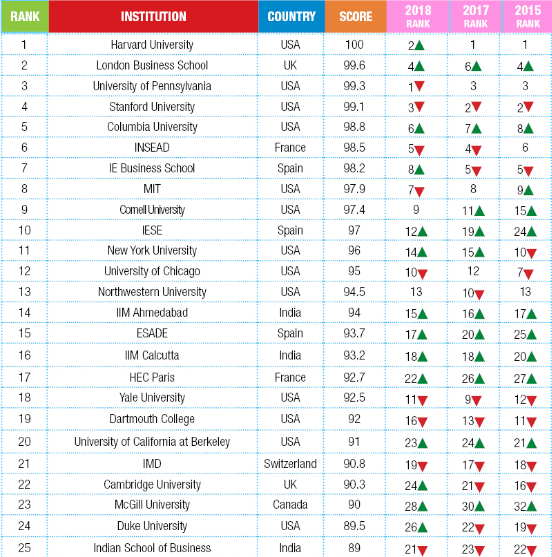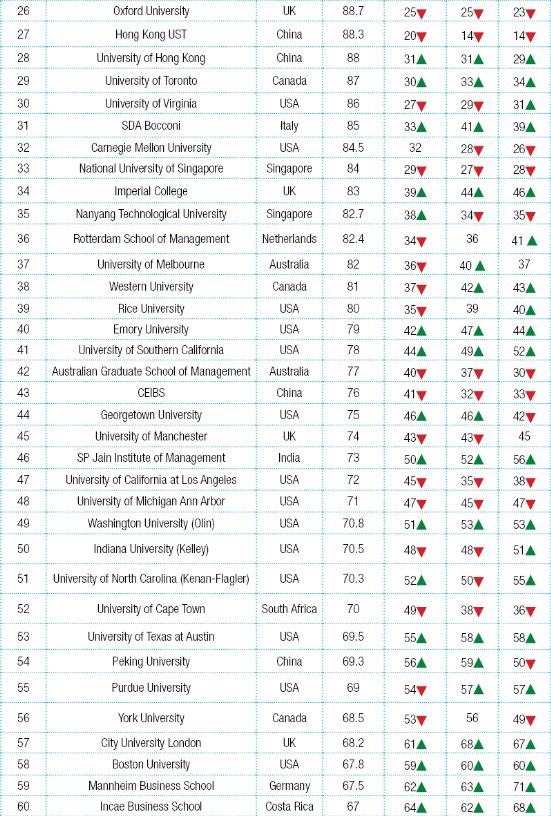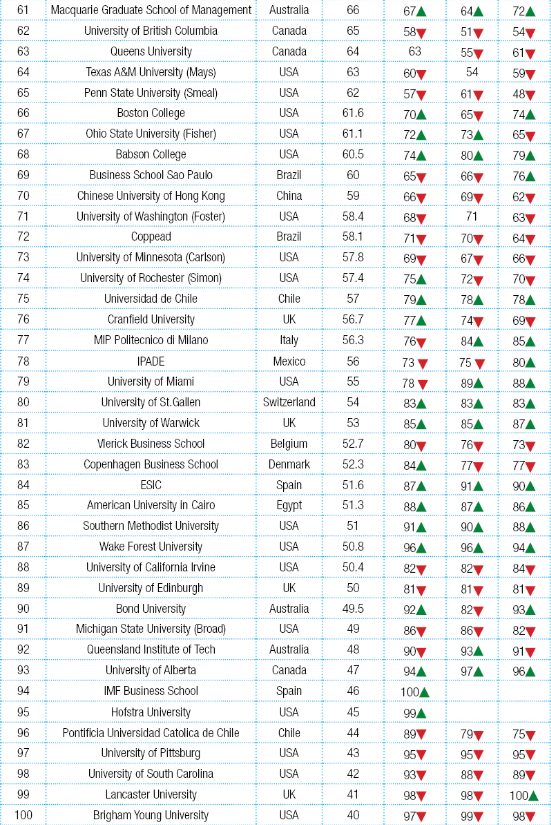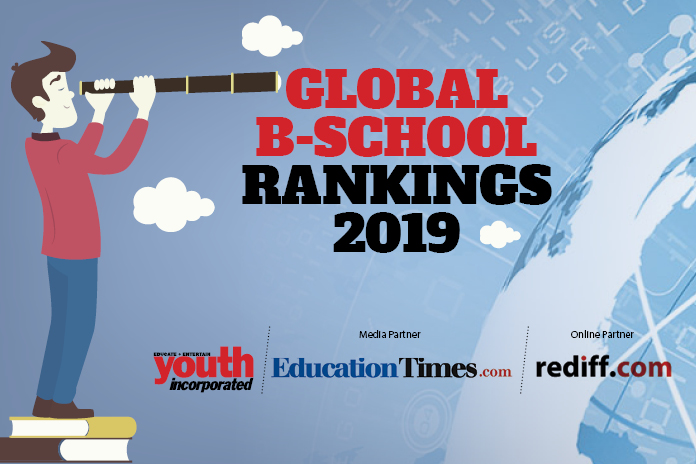MBA degree holders are very much sought after in the job market, and acquiring a degree is no mean feat. With a plethora of universities rolling out MBA degrees for students, it is of utmost priority to make an informed choice. To make this task easier for our valued readers, we at Youth Incorporated have contacted 1800 institutes and had discussions with students, recruiters and faculty, to bring to you the top 100 Global B-School Rankings. We also consulted professional organizations such as AMBA, EQUIS and AACSB. Youth Inc’s Research Unit (YRU) also studied domestic rankings in various countries to find the best institutes.
This year’s rankings saw Harvard University take back its pole position as top ranked B-School in the world from University of Pennsylvania, which fell to the third position this year. The 2nd rank was occupied from London Business School, a two-rank jump from last year’s 4th place. Stanford University occupied 3rd place this year, whereas Columbia University rounded off the top 5. This year saw two Spanish business schools in the top 10 category – IE Business School and IESE Spain – which IE was already in the top 10 last year, IESE moved up from last year’s 12th rank. American universities have been consistently at top positions, as observed over the years.
This year also saw the standard four Indian Institutes making the cut, however, there has been a significant progress. IIM Ahmedabad moved up on position this year to the 14th rank, whereas IIM Calcutta moved up two ranks to the 16th position. The Indian School of Business observed a decline in its rankings, moving from the 21st rank last year, to 25th this year. SP Jain Institute of Management continued its steady climb on the list with a four space jump, at 46th rank this year from last year’s 50th rank.
With the considerable progress observed with Indian B-Schools over the years, we hope to see more Indian universities make their way to the list in the coming years.



RANKING METHODOLOGY
How did we choose institutes?
We contacted 1800 institutes and had discussions with students, recruiters and faculty. We also consulted professional organizations such as AMBA, EQUIS and AACSB. Youth Inc’s Research Unit (YRU) also studied domestic rankings in various countries to find the best institutes.
All the institutes were sent identical surveys. We then contacted current students, alumni as well as local and international recruiters and gathered specific information about the institutes.
Factors considered
- Recruiter Perception – Identical surveys were sent to recruiters worldwide. The recruiters were asked to rate the institutes that they were most likely to recruit from. The recruiters were also asked to rate the students they have recruited from specific business schools on several criteria including leadership potential and strategic thinking.
Diversity of Students – The institutes were asked to report the total number of students on campus and what percentage of the students were international and speak two or more languages. Gender diversity of the students was also considered.Diversity of Faculty – The institutes were asked to report the total number of faculty on campus and what percentage of the faculty was international, hold a doctorate degree and accredited with their own publishing material. Gender diversity of faculty was also considered.Innovation of Programs – We considered the different ways to construct degree programs, as well as the choice students, have in terms of selecting electives.- Innovation in Teaching Methodologies – Institutes were asked to select different teaching methodologies that we considered innovative. Some of these included company visits, dual or multiple majors and course collaborations between different departments at the institute. Our list was selected after surveying students across different campuses worldwide.
- Value for Money – We considered students and alumni opinions on whether a particular institute was perceived as ‘value for money’. We also asked institutes to state the percentage of students who received some sort of funding from the institutes.
- Campus Support – We asked the institutes, current students and alumni to select the different types of assistance provided by the student office or a similar body on campus. Our list was selected after surveying students across different campuses worldwide.
- Career Service – We asked the institutes, current students and alumni about the availability and functioning of a career service cell and how active such a service was for the students. We also considered what percentage of students were actually placed through the institute’s career service cell, how long it look for such
placements and what the average starting salaries were. - Exchange Programs –
Institutes were asked to report the percentage of students that opted forexchange programs . We also considered the exchange students present onthe institute’s campus. - Student Satisfaction – Current
students and alumni were asked to rate their institutes on various factorsincluding career services,attitude of staff and professors, location, andcourse content .
Actual Methodology
Institutes were provided a link using which they could send us their completed survey online. They were asked to answer questions relating to full time faculty, career service, student and program information and all the factors listed above.
We contacted current students and alumni of the institutes and asked them to rate specific statements which were pertaining to the factors we considered in this ranking. All the institutes preferred to send the survey links to their students and alumni directly.
Over 17000 recruiters were sent emails with a survey. The recruiter list was prepared from the responses of the institutes and also included internationally well known recruiters. The recruiters were asked to enlist institutes that they were likely to recruit from.
Below is a summary of the factors and the weight-age given to each factor when we ranked the institutes:
| Information reported by the institute | Information reported by current students | Information reported by alumni | |
| Diversity of Students | 2% | 2% | 2% |
| Diversity of Faculty | 2% | 2% | 2% |
| Innovation of Programs | 2% | 2% | 2% |
| Innovation in Teaching Methodologies | 2% | 2% | 2% |
| Value for Money | 2% | 2% | 2% |
| Campus Support | 2% | 2% | 2% |
| Career Service | 4% | 4% | 4% |
| Exchange Programs | 2% | 2% | 2% |
| Student Satisfaction | 2% | 2% | 2% |
| 20% | 20% | 20% |
| Information reported by recruiters | |
| Recall of institute where to recruit from | 10% |
| Likelihood of recruiting from same institute again | 10% |
| Overall satisfaction with students recruited | 10% |
| Satisfaction with institute career cell | 10% |
| 40% |
Each factor was made up of a set of questions. The total percentage attributed to that factor was based on the average score of the responses multiplied by the assigned weight-age. We then totalled the score from all factors and sorted the scores from highest to lowest. The institute with the highest score was ranked 1st.
Not just numbers!
After we received the total computed scores for the institutes, we subjectively analyzed the data provided by the institutes, current students, alumni and recruiters. If we found discrepancies in the satisfaction scores and the subjective descriptions, we omitted the data.
Institutes that did not fill out the survey reports in time
Out of the institutes that were contacted, 121 institutes did not complete the survey on time or did not respond. We used publicly available information on the institutes to include them in our ranking. We also contacted current students, alumni and recruiters of these institutes and compared the data we received with the data from institutes that did participate.
Special notes
Masters in Finance – The programs include the pre-experience as well as the post-experience Masters programs. The ranking also includes the programs which are recently established.
Masters in Management – Certain Masters of Management programs with specializations are also included in the ranking.
Masters in Marketing – Combination courses of Marketing with communication and other fields are also included in the ranking.
Online MBA – Certain factors such as Campus Support and Exchange Programs were omitted in the factors considered for the ranking.
Executive MBA – Certain factors such as Campus Support and Exchange Programs were omitted in the factors considered for the ranking.
For the above 5 rankings, scores obtained by the institutes were rounded off.



























